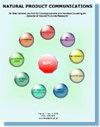通过时基分馏和酶活性测定从芪蛭羌活胶囊传统中药处方中发现α-葡萄糖苷酶/乙酰胆碱酯酶抑制剂
IF 1.4
4区 医学
Q4 CHEMISTRY, MEDICINAL
引用次数: 0
摘要
方法采用基于时间的分馏、LC-QTOF-MS、酶活性测定、分子对接和成分-靶标关联分析相结合的新策略从芪蛭降糖胶囊中发现α-葡萄糖苷酶/乙酰胆碱酯酶抑制剂。采用基于时间的分馏结合酶活性测定法来确定活性化合物在中药处方中的分布期。采用 LC-QTOF-MS 分析活性化合物的结构。结果根据时间分馏法,QLQX中乙酰胆碱酯酶的活性成分主要集中在高极性区域,而α-葡萄糖苷酶的活性成分主要分布在中等极性区域。通过与化学参考物质进行比较,共鉴定出 33 种化合物。从 QLQX 中鉴定出二氢丹参酮Ⅰ(16.98 µM)、羟基红花黄色素 A(84.57 µM)、丹参酚酸 A(76.62 µM)和隐丹参酮(112.68 µM)为乙酰胆碱酯酶抑制剂。同样,迷迭香酸(62.29 µM)、异绿原酸 A(17.95 µM)、4,5-二咖啡酰奎宁酸(117.93 µM)、丹参素(207.88 µM)、丹参酚酸 A(1.31 µM)、3,4-二咖啡酰奎宁酸(91.71 µM)、甲萘素(67.26 µM)、人参皂甙 Rd(3.43 µM)、人参皂甙 Rb1(26.37 µM)和人参皂甙 F1(18.79 µM)被发现为α-葡萄糖苷酶抑制剂。值得注意的是,丹酚酸 A 对乙酰胆碱酯酶和 α-葡萄糖苷酶都有抑制作用。分子对接结果表明,氢键、疏水作用和 Pi-Pi T 形作用是抑制乙酰胆碱酯酶的关键。结论QLQX 含有多种乙酰胆碱酯酶和α-葡萄糖苷酶抑制剂,显示了其对阿尔茨海默病和糖尿病的潜在治疗功效。本文章由计算机程序翻译,如有差异,请以英文原文为准。
Discovery of α-Glucosidase/Acetylcholinesterase Inhibitors from a Traditional Herbal Prescription of Qi-Li-Qiang-Xin Capsule by Time-Based Fractionation and Enzymatic Activity Assay
ObjectivesThe aim is to discover α-glucosidase/acetylcholinesterase inhibitors as lead compounds from a traditional herbal prescription of Qi-Li-Qiang-Xin capsule (QLQX).MethodsA novel strategy combining time-based fractionation, LC-QTOF-MS, enzymatic activity assay, molecular docking and component-target association analysis was performed to discover α-glucosidase/acetylcholinesterase inhibitors from QLQX. Time-based fractionation combined with enzymatic activity assay was used to find the distribution period of active compounds in the herbal prescription. LC-QTOF-MS was used to analyze the structure of active compounds. Molecular docking was applied to explore the interaction between active compounds and targets.ResultsAccording to time-based fractionation, the active components of QLQX for acetylcholinesterase were primarily concentrated in the highly polar region, whereas the active components for α-glucosidase were predominantly found in the moderately polar area. A total of 33 compounds were identified by comparing with chemical reference substances. Dihydrotanshinone Ⅰ (16.98 µM), hydroxysafflor yellow A (84.57 µM), salvianolic acid A (76.62 µM) and cryptotanshinone (112.68 µM) were identified as acetylcholinesterase inhibitors from QLQX. Similarly, rosmarinic acid (62.29 µM), isochlorogenic acid A (17.95 µM), 4,5-dicaffeoylquinic acid (117.93 µM), danshensu (207.88 µM), salvianolic acid A (1.31 µM), 3,4-dicaffeoylquinic acid (91.71 µM), formononetin (67.26 µM), ginsenoside Rd (3.43 µM), ginsenoside Rb1 (26.37 µM) and ginsenoside F1 (18.79 µM) were discovered as α-glucosidase inhibitors. Notably, salvianolic acid A inhibited both acetylcholinesterase and α-glucosidase. The results of molecular docking indicated that hydrogen bonds, hydrophobic interactions and Pi-Pi T-shaped interactions were crucial for inhibiting acetylcholinesterase. Meanwhile, hydrogen bonds, hydrophobic interactions and Pi-Pi stacked interactions were significant in suppressing α-glucosidase.ConclusionQLQX contains numerous acetylcholinesterase and α-glucosidase inhibitors, demonstrating its potential therapeutic benefits for Alzheimer's disease and diabetes.
求助全文
通过发布文献求助,成功后即可免费获取论文全文。
去求助
来源期刊

Natural Product Communications
工程技术-食品科技
CiteScore
3.10
自引率
11.10%
发文量
254
审稿时长
2.7 months
期刊介绍:
Natural Product Communications is a peer reviewed, open access journal studying all aspects of natural products, including isolation, characterization, spectroscopic properties, biological activities, synthesis, structure-activity, biotransformation, biosynthesis, tissue culture and fermentation. It covers the full breadth of chemistry, biochemistry, biotechnology, pharmacology, and chemical ecology of natural products.
Natural Product Communications is a peer reviewed, open access journal studying all aspects of natural products, including isolation, characterization, spectroscopic properties, biological activities, synthesis, structure-activity, biotransformation, biosynthesis, tissue culture and fermentation. It covers the full breadth of chemistry, biochemistry, biotechnology, pharmacology, and chemical ecology of natural products.
Natural Product Communications is a peer reviewed, open access journal studying all aspects of natural products, including isolation, characterization, spectroscopic properties, biological activities, synthesis, structure-activity, biotransformation, biosynthesis, tissue culture and fermentation. It covers the full breadth of chemistry, biochemistry, biotechnology, pharmacology, and chemical ecology of natural products.
 求助内容:
求助内容: 应助结果提醒方式:
应助结果提醒方式:


